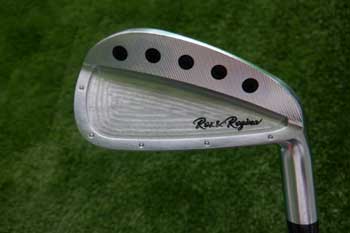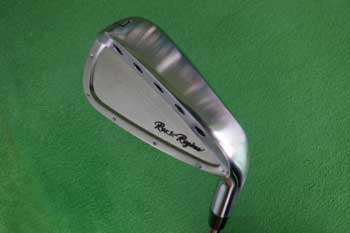BALDO TT FORGED TOUR POCKET IRON TP SATIN Review: Thorough Verification of Soft Iron Pocket Cavity’s Control & Feel

Recently, I had the opportunity to test this golf club.
The test club was the 7-iron of the BALDO TT FORGED TOUR POCKET IRON TP SATIN.
In this article, I will review it in detail, focusing on feel, distance performance, control, and forgiveness. I will convey a realistic sense of use for intermediate to advanced golfers.
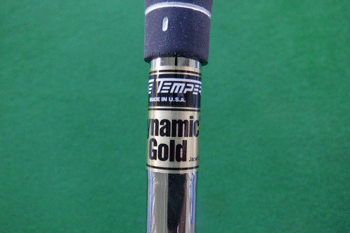
The shaft is Dynamic Gold.
The loft is 30 degrees, the club length is 37 inches, the shaft flex is S200, the balance is D1.5, and the total club weight is 439g.
Appearance

This is Baldo’s beautiful pocket cavity iron.
I’ve seen many pocket cavity irons before, but I was surprised at how beautiful Baldo could make one.
The texture is also great, making it enjoyable just to look at.
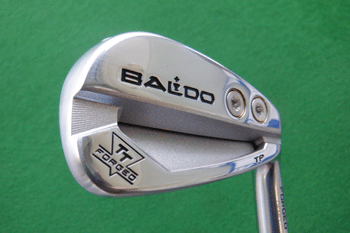
The cavity section looks like it has a large opening.
The shape of this opening made it look like it was smiling.
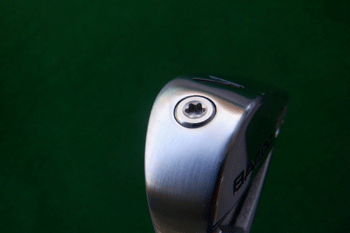
A weight is placed on the toe side.
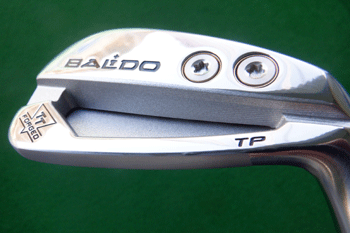
Looking at it this way, you can see that the carving is quite deep, and it’s a thick pocket cavity iron.
I wondered what “TP” meant, but I think it probably stands for “TOUR POCKET.”
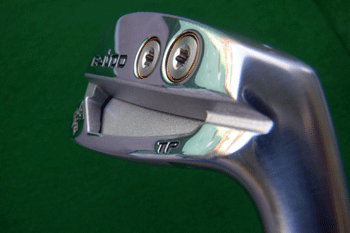
Even from a different angle, you can see that the sole part is quite thick, indicating a low center of gravity.
Compared to drivers, irons are clubs with a shallower center of gravity, but even among irons, this one seemed to have a considerably deep center of gravity.
Perhaps because I’m used to them, I prefer high center of gravity irons, but I think many people nowadays prefer low center of gravity irons, and this design might feel familiar to those people.
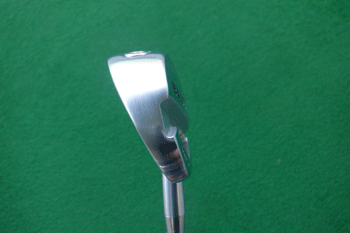
It looked slightly swollen, so I thought it might have a hollow + pocket cavity structure.
Even looking at it this way, the outline is beautiful.
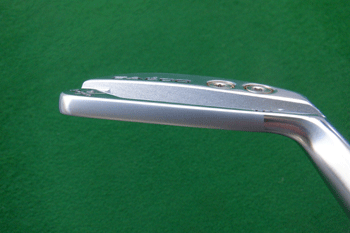
The top line is a little thick, but it’s within the standard range.

Similar to the “TT FORGED TOUR AIR IRON TA SATIN” I tested the other day, two weights are placed on the heel side.
Since there are no numbers, I don’t know the weight.
Looking at it from this angle, it still looks like it’s smiling.

This “TT FORGED” on the toe side is very stylish.
Being a Baldo, I wonder if it’s a meticulously crafted forging.

The word “FORGED” is also on the hosel.
Having tested many irons so far, I’ve learned that just because it’s forged doesn’t necessarily mean the feel will be good, but the words “forged” and “milled” are still attractive.

It has a classic, good-looking face.
This good look is characteristic of Baldo, and could it be called “Baldo’s aesthetics”?
It’s sharp yet has a moderate roundness, giving it a friendly appearance… I thought while looking at it.

The sole looked a little wide, but is this the standard nowadays?
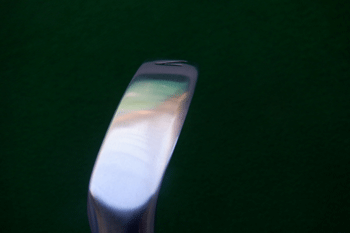
The leading edge is slightly shaved, suggesting good turf interaction.

The trailing edge doesn’t seem to be particularly shaved.
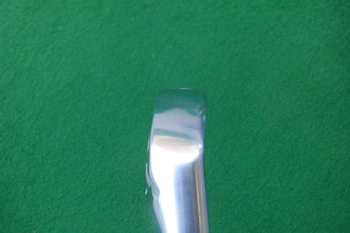
The overall shape of the sole is close to flat, but it has a slight roundness overall, suggesting good glide.
This kind of sole shape has been around for a long time, and you still see it often.

The neck length is standard.

The face has very fine milling.
You can hardly see it unless you look closely, but it is definitely engraved, and it’s not parallel to the score lines, but rather it’s a milling that draws a large circle.
The number of score lines is 12.
You used to see this often, but it feels rare these days. However, the spacing between the score lines is moderately wide, so it feels like the ball will stick (ride) firmly at impact.

The feeling at address with the ball in front is decent.
I really like that it has Baldo’s characteristic straight type, but I prefer a slightly thinner top line.
However, I find the fact that the top line isn’t tightly rounded appealing because it makes it easier to visualize shaping shots.
It wasn’t breathtaking, but it’s a familiar face from the past, and there’s absolutely no problem with it.
I started the test hitting.
Feel
The feel is on the firmer side.
It felt a little thin and hard, but you could say it has that pocket cavity feel.
It’s not the feel I personally look for in an iron, but perhaps it’s a result of pursuing ease of use.
For those who started playing golf with hollow or pocket cavity irons, it might be a familiar and appealing feel.

In terms of how easy it is to get the ball airborne, it excels, and it didn’t feel like a demanding type of iron.
However, I think there are two types of this ease of launch: the low center of gravity type that “lifts automatically” and the high center of gravity type that “launches with solid spin.” This iron feels more like the former.
The ball launches easily, but I’d like to test if I can stop it securely on elevated greens.

The stability is high, and I fully felt the forgiveness of the pocket cavity.
The weight doesn’t escape to the toe side but is on the heel side, which makes it easy to control, and I like that you can easily use your hand feel.
Many people may feel that a toe-weighted iron (with a longer center of gravity distance) provides more stability and ease, but I find irons with the weight gathered somewhat on the heel side easier to use, so I felt an affinity for this iron.
That being said, it doesn’t feel like a completely heel-weighted iron either.
This “easiness” also varies depending on the type and preference of the user, so there’s no single right answer.

The workability is pretty good.
When I addressed the ball, I thought it would have a more manual-type of handling, or rather, “responsiveness,” but when I actually hit it, the “forgiveness of the pocket cavity” was strong, giving it an automatic feel.
You can shape shots when you want to, but rather than big curves, it’s an iron that allows you to play with small bends.
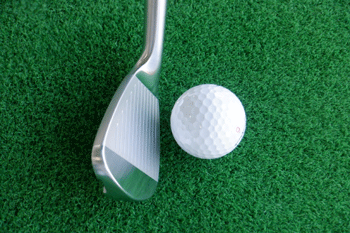
The distance performance is high, but it feels like it falls into the standard category among today’s distance-oriented irons.
Distance-oriented irons are still mainstream, but before I knew it, that became the standard, and hitting over 170 yards with a 7-iron has become commonplace.
It’s clearly too much distance for me, so I wouldn’t use it, but the fact that every manufacturer is adopting it means there’s a demand for it, and I think this iron firmly meets that need.
Come to think of it, I don’t see many 7-irons with a 34-degree loft anymore.
Even the weaker models often have 32 or 33 degrees.
For me, it’s clearly a “number shift,” and 32 degrees feels ingrained in me as a 6-iron, so it doesn’t appeal to me.
If 32 or 33 degrees becomes the “minimum line” instead of 34 degrees, I won’t buy any irons in the future.
Not only major manufacturers but also JDM (Japan Domestic Market) manufacturers seem to be following this trend.
However, some manufacturers offer “custom” options, allowing you to choose not only the “lie angle” but also the loft to suit your needs, so for now, those are the only options I feel I have.
Some people might say that lie angle and loft don’t matter, but I consider them important.
A 7-iron with a loft stronger than 33 degrees doesn’t appeal to me.

It’s a beautiful iron with good texture.
Pocket cavity and hollow irons used to have a strong image of stainless steel, but it seems like the number of soft iron models has increased.

A friend told me that there’s a forging iron boom right now.
Forged irons have been around for a long time, but why has forging become popular now?
Personally, I would be happy if it meant that many golfers have realized the importance of a lie angle that suits them, but I don’t know the actual reason.

Naturally, the lie angle of this iron can also be adjusted.
【Summary】The BALDO TT FORGED TOUR POCKET IRON TP SATIN is Recommended For:
Golfers who want to balance the soft feel of forged iron with forgiveness.
Those who prioritize a cool and stylish appearance.
Intermediate to advanced golfers looking to stabilize their scores.






